
In 2018, the Intergovernmental Panel on Climate Change (IPCC) put the world on notice: To avert catastrophic and irreversible climate change we will have to hold global warming to 1.5°C above pre-industrial levels. And to hold warming to this level, we must cut global emissions roughly in half by 2030 and get to zero by 2050.
The building sector is a huge part of the problem, accounting for roughly 40% of global annual emissions. And while our industry has made progress, we haven’t done nearly enough. Along with the work of organizations such as the Carbon Leadership Forum and Architecture 2030, the IPCC report was a wake-up call about the time value of carbon. Larry Strain, a board member at the Carbon Leadership Forum, describes it this way: “Because emissions are cumulative and because we have a limited amount of time to reduce them, carbon reductions now have more value than carbon reductions in the future [emphasis added].”
Three strategies are critical to achieving meaningful near-term reductions in building sector emissions. First, we need to repurpose buildings wherever possible rather than build new. Second, we need to aggressively reduce the operating emissions of existing buildings. Third, we need to build with low embodied carbon materials, and ideally with carbon-storing materials.
The first two strategies are firmly ensconced at Byggmeister. We don’t do new construction, we avoid additions, and we pursue operational emissions reductions whenever possible. However, until the last couple of years, we had not paid much attention to embodied carbon. We assumed that whatever carbon we emitted to renovate and retrofit homes would be balanced by operational savings over decades. But this assumption was flawed.
So, we turned our attention to embodied emissions, focusing first on insulation. As remodeling contractors, we know that insulation is high leverage, especially because closed-cell spray foam—one of the highest embodied carbon insulation materials on the market—has long been a go-to insulation material for us. There are good reasons we have relied so heavily on closed-cell spray foam. It blocks air leaks in addition to reducing conductive heat loss; it’s vapor impermeable; and it’s highly versatile. But none of these is a good reason to maintain the status quo.
Deciding when to use foam
There are times when replacing spray foam with a carbon smarter material is a no-brainer. For example, installing cellulose in wood-framed walls is typically no more complex than insulating with spray foam, not to mention less expensive and less disruptive. And while the R-value of a cellulose-insulated wall is lower than the same wall insulated with closed-cell spray foam (unless the wall assembly is thickened), we believe this compromise is worth it. The reduced R-value has little impact on comfort and the carbon benefit more than makes up for it. Unlike spray foam, which emits a lot of carbon before, during, and immediately after installation (this is especially true of closed-cell spray foam with high-embodied-carbon blowing agents), cellulose actually stores carbon.
There are other cases, though, such as with rubble foundation walls, when we feel spray foam is the only viable choice, other than not insulating at all. While we have entertained this possibility, we aren’t willing to give up remediating dank, damp basements although we have begun to think about these as emissions that should be offset with more aggressive carbon-storing measures elsewhere.
Much of the time, though, the choice to eliminate or retain spray foam isn’t clear-cut. We encounter many roofs and attics where existing conditions, code requirements, and broader project goals make it challenging but not impossible to avoid spray foam.
If the attic is unconditioned, then the easiest, most-cost effective strategy is to air seal any penetrations along the attic floor and then re-insulate (in most cases we would first remove existing insulation).
But this only works if there’s no mechanical equipment (and ideally no storage). If the attic is used for anything other than insulation, best practice is to bring the attic space indoors, either by insulating the underside of the roof sheathing with spray foam, or by removing the roofing, insulating the topside of the roof sheathing with rigid foam and then re-roofing.
If the roof needs to be replaced, “outsulation” might initially seem viable. But I can count on one hand the times we have actually done it. More often than not it’s doomed by cost or adverse architectural consequences. This is why spray foam has long been our go-to approach for unconditioned attics with HVAC equipment.
New approaches for lower carbon
At least it was, until we realized just how carbon-intensive it is. We came to this realization by comparing the embodied emissions of spray foam against four alternatives. We based these comparisons on a simple gable-roof form. The four alternatives we looked at were:
- A low-foam approach of building down the rafter bays, insulating with closed-cell foam for condensation control, followed by cellulose behind a smart membrane.
- A no-foam approach where the air and thermal boundary remains at the attic floor. We install the air handler in a conditioned “head house” and bury the ductwork in cellulose.
- A common outsulation approach with cellulose in the rafter bays plus exterior polyisocyanurate board foam.
- A newer, no-foam outsulation approach with cellulose in the rafter bays plus exterior wood fiber board.
All of these approaches, including exterior polyisocyanurate, are either carbon neutral or carbon storing from the outset. Only spray foam starts off in carbon debt.
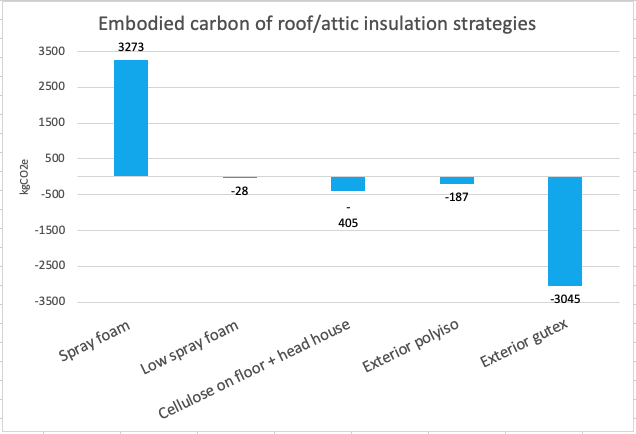
And this debt is not small. Our modeling suggests this particular measure would take 14 years of operational carbon savings to break even. Even if our model isn’t exact, it’s close enough to know that spray foam should not be our default approach if there are viable, lower emitting alternatives.
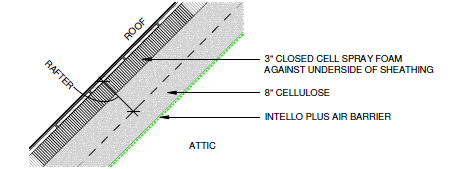
In subsequent posts, we will walk through the no-foam, head house approach in detail. We also will describe our efforts to develop a carbon-smart approach to another common attic/roof condition: poorly insulated, finished slopes. When such slopes are topped by a “micro attic,” we are experimenting with dense-packing the slopes, installing loose-fill cellulose along the floor of the micro-attic, and adding a ridge vent.
Both of these approaches seemed impractical when we first took them on. Both present some level of risk. Because of code constraints, the second one may not be broadly replicable even if we can demonstrate that the risk is manageable. But if we are going to cut global carbon emissions in half by 2030 and get to zero by 2050, we’ll have to take some risks and pursue approaches that aren’t (yet) standard practice. By sharing our story, we hope to inspire more of our colleagues to join in this effort.
Rachel White is the CEO of Byggmeister, a design-build remodeling firm in Newton, Mass.
Weekly Newsletter
Get building science and energy efficiency advice, plus special offers, in your inbox.




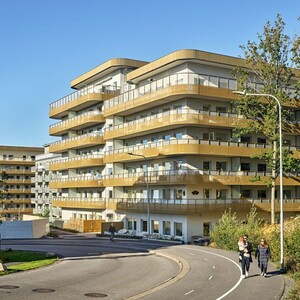
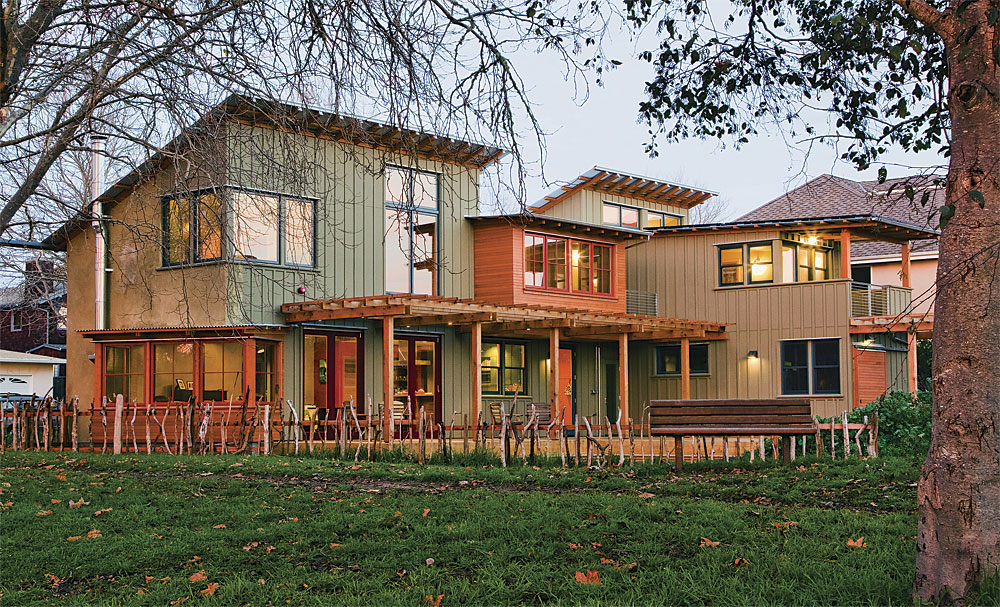

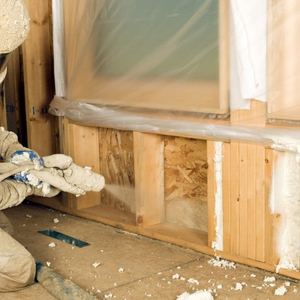






34 Comments
Good and important discussion.
Is your bar graph of embodied CO2 for for HFC blown closed cell spray foam or HFO blown?
Thanks for asking, I was wondering this as well--we're specifying the HFO, and in situations where we have a dizzying array of trusses (hip roof etc) it seems that ccspf is the way to go...
It's for HFO foam.
I haven’t seen Aerobarrier (and other misted caulk brands) come up as a solution to replacing spray foam air sealing much, yet. Is it viable to replace spray foam, especially in the “low foam” situations where spray foam is providing mostly air sealing?
Also, does anyone know if Aerobarrier off-gases VOCs? How does it stack up for carbon and VOCs with other measures like liquid flashing and closed cell?
The purpose of the spray for in the roof assembly shown in the last figure is not primarily air sealing. It's providing a layer that doesn't hold moisture or allow water vapor diffusion, and so prevents condensation on the underside of the roof deck.
Great article! Thanks. Yes, those of us in the construction industries MUST take responsibility for minimizing carbon NOW. I swore off of spray foam years ago for health/IAQ reasons but have only recently discovered Gutex (and other wood fiber insulations) as an option for roof outsulation (as well as other applications). With increased use of these more responsible products, hopefully the costs will come down and availability will improve.
Hi Gayle:
I’m interested in advancing a scalable DER model SF and multi-family homes. I live in Minneapolis. To that end, I have been watching a Maine based company (Timber HP) that is one year away from selling wood-fiber insulation. I find the fact that the US will now have domestic wood-fiber insulation very exciting. I am aware of Gutex, but my research shows that it is 4x the cost of big box EPS. I'm told Timber HP's product will be competitive with EPS.
Recently I reached out and zoomed with Timber HP founder Matt O'malia and CMA Scott Dionne. I organized a zoom and they both were kind enough to meet with me, which I really appreciated because I'm just one person. They both expressed interest in giving a zoom product presentation to the building community in Minnesota and I volunteered to facilitate and host. After we hung up, it dawned on me that it would make more sense to expand the zoom call to other areas of the US. I'm happy to coordinate. I'm wondering if you and your team would be interested in joining the presentation? The more obviously the better. Perhaps there is a way for someone at GBA to put out a inquiry and see how much interest we could generate.
Here's a few links to the Timber HP product as well as their retrofit model ideas:
Timber HP: Wood Fiber Manufacturing Startup. Here at the bottom of the page like they designed a retrofit Modular Encapsulation System & Prefab window system and entered it recently in a contest:
https://opalarch.us/innovation
Timber HP: Wood fiber products and specs =(more forthcoming)
https://golab.us/products/
Here's a nice Forbes interview where Matt O'malia talks about the big potential for US manufactured wood-fiber products that sequester carbon etc.
https://www.forbes.com/sites/sherikoones/2020/11/11/a-passive-house-architect-spreading-his-wings/?sh=238de0007f2d
It is nice to see some forward thinking. How does it go, "the best way to predict the future is to create it". Hopefully some of the more eco friendly building materials will become easily available.
We did the 'low foam' option in our attic, because the staircase into the attic made airsealing not so feasible. It took a long time to fur out the rafters and add the rockwool under the foam at roofline and drywall the gable walls, but it saved us a lot of money to do that part ourselves after the professional spraying was done.
I'm curious about a detail mentioned: removing the old insulation before adding new insulation. I can see where this would make sense removing batts to apply spray foam, for instance. However if the existing insulation was still in decent shape, I would think that the most carbon effective approach would be to put it back afterwards. Similar to how a new flash and batt approach would be done.
Wouldn't it be more cost effective (and carbon effective) to hit a given R value using a combination of new insulation and old insulation rather than going 100% with new insulation? I would think that the carbon cost of reusing existing insulation would be lower than that of any new insulation...
Is there some reason it wouldn't make sense to recycle attic insulation?
-J
-J, I'm in the middle of an energy upgrade of a mid-size condominium complex that was built in the 1980's and 1990's. Even though these are somewhat higher-end units that have been well maintained, we've found that the original insulation is in terrible condition - full of rodent urine/feces, mold & water damage and just plain dirt. Nobody would ever consider putting it back in. As we discussed this issue, we were somewhat comforted by the thought that we were simply treating the insulation the same as other depreciating building components. Lots of parts of buildings wear out or otherwise become outdated or unusable. We don't typically think of insulation this way, but in fact we probably should. When these units were built, R-20 insulation was awesome. Now it's not. The insulation did its job in its day and now it's time to upgrade.
This should certainly be a consideration with current materials and techniques. We think we design buildings to last a century or more, but how many of their components will do so? And for something like insulation, when we look at the initial and lifecycle carbon cost, we shouldn't have unreasonable expectations of the real lifecycle. If a material takes 30+ years to pay back its carbon cost, what are the odds that the material will still be in use in 30+ years?
Insulation can be reused if it is in good condition. I reused fiberglass batts (built in 1977) for a cathedral ceiling R-value upgrade. The batts were clean and dry so after installing continuous air chutes the original fiberglass was reinstalled, a bit more (R-30 fiberglass) added to completely fill the rafter space and R-20 polyiso went on the room side. Most building components do need replacement, roofs, windows and often siding. One area that can last the life of a house is hardwood floor. The 3/4" oak strip hardwood can be refinished over and over and retains its beauty. Wood siding can last if properly sealed on all sides before installation.
A lot of this depends on the condition of the insulation. There are plenty of cases where I've seen batt or loose fill insulation that's an awful mélange of coal dust, mouse urine and feces, and other unmentionables... I think that occurs often enough that the typical contractor approach is "throw it out and start fresh" to avoid risks.
Reduce, Reuse, Recycle. The amount of waste generated by the construction industry is eye popping. Roll-off after roll-off of construction scraps from one new build and at the end of the day the new build is an energy waster. The construction industry needs to look inward like the author of this article has done.
A townhouse project I am familiar with is replacing all of the asphalt (30 year) roofs after 15 years because they are claiming hail damage. At the same time cars parked out side during the storm in question had little or no damage. They are also to replace the gutters and downspouts. A multi million dollar roofing replacement that is likely not needed adding price pressure to already costly building materials.
Hi JHCT and Doug, I work with Rachel and as she mentioned in the article we have removed the existing insulation in some cases but not all and recently we've been trying harder to leave the insulation in place whenever we feel we can. As Kohta and Peter described, the existing insulation we are finding in most of our projects is in very poor shape and often a combination of old deteriorating batt insulation, possibly some loose blown, and a lot of other junk/nasty stuff mixed in. This can make it very challenging to create a good air barrier which is key to both reducing operational carbon emissions going forward and managing moisture to ensure various building materials won't need early replacement. We are lucky to work with a committed air sealer and have carpenters we trust to rise to that challenge, however sometimes we feel it's best to remove the old and start fresh. In our next posts we will describe in more detail some of the ways we've tried to preserve existing insulation.
Thanks Brendan (and all the other folks who commented)!
I was thinking just from a carbon perspective and missed the elephant (droppings) in the room.
-J
Also, how is wood fiber board turning out to cost relative to rigid foam board? I have heard there’s only imported Gutex and one company starting a plant in the US (spun off GO Logic?) — are there any other sources of it?
Matt, you can order Stecio through their US importer.
https://web.steico.com/en/
There is also a mill in Quebec that make a wood fiber board. I can't recall their name but I have it filed away if you want me to find it.
There was an article last year on GBA mentioning there was expected to be a source of exterior wood fiber board produced in USA (Maine) in early 2021 but unfortunately I just checked their site (golab.us) and it now says 2022. So it seems like in the USA we still have to import it.
The production equipment recently arrived in Searsport Harbor, ME but they are waiting for the ground to firm up before transporting it across the state. That's according to this Bangor Daily News article
https://bangordailynews.com/2021/02/23/news/production-equipment-for-countrys-first-wood-fiber-insulation-plant-arrives-in-maine/
Thanks for the info, David and Ross.
Would it be possible to show how the calculations were done for the Embodied Carbon chart? Could you say more about the assumptions used in the chart? For example, what insulation R value was assumed for each case and how large was the insulated roof?
I'm attaching the spreadsheet showing the embodied carbon calculations for each assembly. This spreadsheet also calculates the "carbon payback" for each assembly using operational savings modeled in SnuggPro. And it calculates the embodied carbon for the other envelope measures implemented at this project (which I did not discuss in this post). These other measures are: densepacked cellulose in the exterior walls and closed cell spray foam along the basement walls.
Sorry the spreadsheet is too large to post. I've attached it as a pdf, which I realize is not nearly as helpful as the spreadsheet. (I also tried zipping the spreadsheet but it was too large).
Thanks for posting this. Any chance you have a similar analysis embodied carbon for fiber cement siding vs FJ cedar and other siding types?
Thanks
Wonderful to see this. Also excited to see the calculations (perhaps as a spreadsheet or even a Jupyter/rmarkdown notebook?)
I’m a little confused as to how polyiso ends up carbon negative? Is that including operational savings over some time period? (But caption says embodied carbon, so that doesn’t seem right?)
Would also be great to lay out comparative figures for the amount of COe saved. Perhaps in terms of a) percentage of annual emissions for households and b) if applied to all retrofits in the country/world :)
I'm thinking the cellulose included in the exterior polyiso design would negative, while the polyiso is positive. How that balances depends on how much of each. Also maybe it's reclaimed polyiso.
Ah, that's probably it, I was confused by the label on the chart, but that's a shorthand for the combination of polyiso plus cellulose. Thanks!
Sorry for the confusion, James. Charlie is correct: the whole assembly has slightly negative emissions because the cellulose more than balances out the polyiso.
Really useful article! Could you expand on this? "A low-foam approach of building down the rafter bays, insulating with closed-cell foam for condensation control, followed by cellulose behind a smart membrane."
What is "building down" the rafter bays?
Do you insulate with only enough foam for air sealing, or are you filling the entire rafter bays? If the latter, how is that a "low-foam" approach?
If the foam handles air-sealing, why is a smart membrane needed?
I would imagine "building down" refers to furring down the rafters to give the extra insulation depth. Probably more choices for furring methods than something like a cathedral ceiling though, if spacing and attaching the membrane are the most important parts (instead of needing to support and attach drywall).
The smart membrane would form the required interior air barrier for the insulation, and allow vapor transfer as well. The foam will not allow drying to the exterior, so the membrane would be a method to dry to the interior.
Thanks, I realized what "building down" meant right after I clicked Submit. Whoops.
I'm afraid I'm not following you at all on the smart membrane. What happens if you don't use it?
Besides forming the bottom side of insulation cavity to contain the (loose) cellulose, something is needed to prevent air motion and convection losses, which decreases the effectiveness of the insulation.
So the air barrier is the most important function from an insulating standpoint, but the vapor permeability is required for moisture management that can't be handled by the impermeable spray foam. If a non-permeable membrane was used (poly sheet or whatever), air leakage into the insulation cavity could cause trapped condensation, same with any other source of moisture in the insulation cavity. There would be no drying potential to either the interior or the exterior side. I think that may be what you're asking.
If it was an interior space instead of an attic space, some/all of those functions could be handled by finished drywall, but the smart membrane would usually be faster/easier/cheaper etc. for an attic install, and probably easier access if future maint is needed.
Okay, that's very helpful, thank you.
Log in or create an account to post a comment.
Sign up Log in